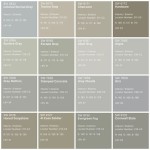Is There a Way to Match Paint Color?
Achieving a perfect paint color match is a common goal for homeowners undertaking renovation projects, artists seeking to replicate specific hues, and even automotive enthusiasts repairing bodywork. The ability to precisely match an existing color allows for seamless blending, hiding imperfections, and maintaining a consistent aesthetic. Fortunately, advancements in technology and techniques have made paint color matching more accurate and accessible than ever before. However, successful paint matching isn't always a simple process and often requires a combination of careful observation, the right tools, and a degree of understanding of color theory.
The ideal scenario for matching paint color would involve simply referring to the original paint can and noting the color name and code. Many paint manufacturers provide this information directly on the label. Using this information, any paint store can recreate the color, even years later, assuming the same base paint is still available. Unfortunately, this is rarely the case. Paint cans are often discarded, labels become damaged or illegible, and sometimes the original color was custom mixed, making the retrieval of its formulation impossible.
When the original paint information is not available, alternative methods must be employed. These methods range from manual techniques involving visual comparison and color swatches to sophisticated technologies employing spectrophotometers and computerized color matching systems. The accuracy of each method varies, and the best approach often depends on the specific application, the desired level of precision, and the available resources.
Visual Matching Using Color Swatches
Visual matching is a traditional technique that relies on the human eye to compare a sample of the target color with a collection of pre-existing paint swatches. Paint stores typically offer a wide array of these swatches, organized by hue, value, and chroma. The process involves holding the sample up against various swatches under consistent lighting conditions to identify the closest match. Natural daylight is generally preferred for this method, as artificial lighting can distort colors. This is one of the oldest methods used for matching paint color.
While relatively inexpensive and straightforward, visual matching has inherent limitations. The human eye is subjective and can be influenced by surrounding colors, lighting, and individual perception. Furthermore, paint swatches represent a limited range of colors, and it's unlikely to find an exact match within the available options. Instead, the goal is to identify a swatch that is close enough to serve as a starting point. Once a near match is found, the paint store can often adjust the formula of that swatch to more closely resemble the target color. This often involves adding small amounts of tint to the base paint. The skill of the paint store employee is critical here, as they must be able to accurately identify the slight differences in color and select the appropriate tints to achieve the desired result.
Moreover, the substrate on which the paint will be applied can influence the perceived color. A color that appears to be a perfect match on a paper swatch might look slightly different when applied to a wall with a different texture or underlying color. Therefore, it's advisable to test the matched paint in a small, inconspicuous area before applying it to the entire surface. This allows for any necessary adjustments to be made before committing to the full application.
Factors such as gloss level and the age of the existing paint can also complicate the visual matching process. Over time, paint can fade or yellow, altering its original color. When matching older paint, it's helpful to clean a small area to expose the original color before attempting to find a match. Adjustments may also be needed to account for differences in gloss level, as a higher gloss paint will appear slightly different than a matte finish, even if the underlying color is the same.
Spectrophotometry and Computerized Color Matching
Spectrophotometry provides a more objective and accurate method for paint color matching. A spectrophotometer is an instrument that measures the spectral reflectance of a color across the visible light spectrum. It emits light onto the sample and measures the amount of light reflected at different wavelengths. This data is then used to generate a spectral curve, which is a unique fingerprint for that specific color. Computerized color matching systems use this spectral data to formulate a paint color that closely matches the target sample. This works by comparing the spectral data with a database of existing paint formulas and identifying the best possible match. The system then calculates the exact amounts of different pigments needed to recreate the color.
This technology offers several advantages over visual matching. It eliminates the subjectivity of the human eye and provides a more precise and consistent measurement of color. Spectrophotometers can also detect subtle differences in color that might be imperceptible to the human eye. Furthermore, computerized color matching systems have access to vast databases of paint formulas, increasing the likelihood of finding a close match. The technology offers the best chance of providing an accurate paint color match.
However, even with spectrophotometry, certain limitations exist. The accuracy of the matching process depends on the quality of the spectrophotometer and the comprehensiveness of the paint database. Some systems may not be able to accurately match colors that contain metallic or pearlescent pigments, as these pigments have complex reflective properties. Additionally, the instrument needs to be properly calibrated to ensure accurate readings. The sample presented to the spectrophotometer also needs to be clean and representative of the color being matched. Dirt, dust, or surface imperfections can affect the spectral reflectance and lead to inaccurate results. The user must carefully prepare the sample and ensure that is free from any contaminants.
The process typically involves taking a small sample of the existing paint, such as a loose chip or a painted object. The sample is placed under the spectrophotometer, which measures its color and generates a spectral reading. This reading is then fed into the computerized system, which searches its database for the closest match. The system then displays the formula for the matched paint, which can be used to mix the color. The paint store employee will then use the formula to dispense the correct amounts of different pigments into a base paint.
Alternative Techniques and Considerations
Beyond visual matching and spectrophotometry, other techniques and considerations can contribute to a successful paint color match. For instance, if only a small area needs to be touched up, blending techniques can be used to minimize the visibility of the repair. This involves feathering the edges of the touched-up area into the surrounding paint, creating a smooth transition. Blending is particularly effective when the existing paint has faded or aged, as it helps to mask slight color differences.
Another important consideration is the type of paint being used. Different types of paint, such as latex, acrylic, or oil-based, have different properties and may require different matching strategies. Latex paints are generally easier to match, as they are water-based and readily accept tints. Oil-based paints, on the other hand, can be more challenging to match due to their complex chemical composition and tendency to yellow over time. Understanding the type of paint being used is crucial for selecting the appropriate matching technique and ensuring compatibility between the old and new paint.
When matching paint for exterior applications, it's important to consider the effects of weathering and sunlight exposure. Exterior paints are exposed to harsh environmental conditions that can cause them to fade, chalk, or crack over time. When matching exterior paint, it's advisable to select a paint that is specifically formulated for outdoor use and that is resistant to fading and weathering. Additionally, it's important to clean the existing surface thoroughly before applying the matched paint to remove any dirt, mildew, or loose paint. This will ensure proper adhesion and a more uniform finish.
The gloss level of the paint is another critical factor to consider. Gloss level refers to the amount of light that is reflected from the surface of the paint. Paints are available in a range of gloss levels, from matte to high gloss. When matching paint, it's important to match the gloss level as closely as possible. A difference in gloss level can make even a perfect color match appear visually different. For example, a matte paint will absorb more light and appear less vibrant than a high-gloss paint of the same color. Therefore, it's essential to specify the desired gloss level when requesting a paint match.
Finally, it's important to remember that achieving a perfect paint color match is not always possible. Even with the best techniques and technologies, slight variations may occur. However, by carefully considering the factors discussed above and employing a combination of visual assessment and spectrophotometry, it's possible to achieve a very close match that is virtually indistinguishable from the original color. When slight variations are unavoidable, blending techniques and careful application can minimize their visibility and ensure a seamless finish.

How To Match Paint Color 100 The Easy Way

3 Ways To Match Paint Colors Wikihow

How To Match Paint Colors

Tips For Matching Your Cur Interior Chism Brothers Painting

Color Matching Between Paint Brands Does It Work

The 6 Best Tools For Colour Matching Inspirations Paint

3 Ways To Match Paint Colors Wikihow

Color Matching Between Paint Brands Does It Work

Finding Paint Colors To Match Your Home Decor Expert Tips Porch Daydreamer

How To Match A Paint Color From Picture Entri Ways
Related Posts








